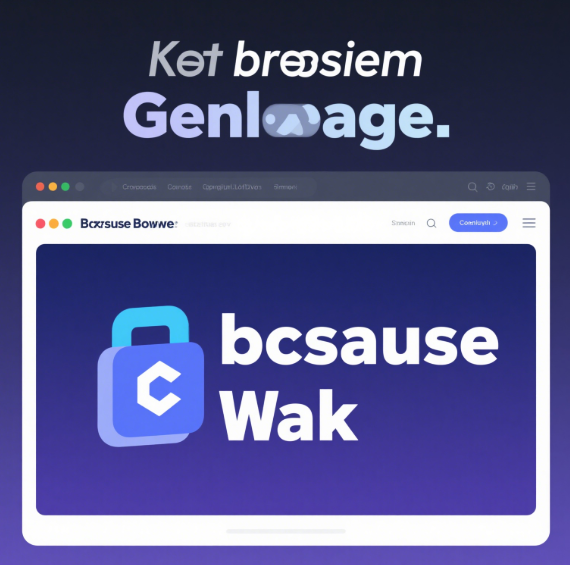In today's booming world of digital assets, cryptocurrency wallets have become crucial tools for investors to protect their wealth and avoid asset losses. For users of browser-based wallets, a sudden malfunction or data loss can significantly elevate the risk to their assets. So, how can you effectively respond to wallet damage and safeguard your investments? In this article, we'll explore this issue step by step and provide a range of practical advice and best practices to help you better protect your digital assets.
1. Why Choose a Browser-Based Wallet?
Before diving into how to protect your assets, let's first understand the advantages of browser-based wallets. Wallets like MetaMask and Trust Wallet are widely popular due to their ease of use, simple installation, and compatibility with many decentralized applications (DApps). Users can easily conduct cryptocurrency transactions, manage assets, and participate in the blockchain ecosystem.

However, the convenience of these wallets also comes with certain risks, including computer viruses, malware attacks, and unexpected browser failures that may lead to data loss. Understanding these risks helps us formulate effective countermeasures.
2. Common Causes of Browser Wallet Damage
Software Malfunctions: Updates to browsers or extensions can introduce incompatibilities that prevent wallets from functioning correctly.
Malware Attacks: If a computer is infected with malware, attackers can steal wallet data or conduct unauthorized transactions.
Data Loss: Unexpected system crashes, hard disk failures, or network issues can result in unrecoverable data.
User Errors: Actions such as accidentally deleting files or misconfiguring wallet settings can also lead to asset loss.
Recognizing these potential hazards is the first step in developing preventive measures.
3. How to Avoid Asset Loss Risks
1. Regularly Back Up Your Wallet
Backing up your wallet is one of the most critical steps in protecting your digital assets. Regular backups can prevent the risk of data loss. Your browser wallet usually provides options to export your seed phrase or private key. Follow these suggestions for effective backup:
Export Seed Phrase or Private Key: Look for the export option in your wallet settings and securely record your seed phrase or private key. Ensure you perform this operation in a private setting to avoid prying eyes.
Multi-Channel Backup: In addition to paper records, consider storing backups on secure cloud services or encrypted USB drives. Never rely solely on a single backup method.

2. Enable Two-Factor Authentication (2FA)
Activating two-factor authentication (2FA) is an effective way to increase security. Many browser-based wallets support integration with mobile apps (like Google Authenticator) for an extra security layer.
Set Up 2FA: Whenever someone tries to make a transaction from your wallet, they will be required to input a text message verification code or a code from an authentication app. Even if a hacker obtains your password, they cannot conduct transactions without the additional code.
Regularly Update Your Password: Additionally, make it a habit to periodically change your wallet password and use strong passwords (including letters, numbers, and symbols) to further reduce risks.
3. Keep Software Updated
It is crucial to ensure that your browser and wallet extensions are always up to date. Developers release updates to fix vulnerabilities and enhance security regularly.
Enable Automatic Updates: Whenever possible, set your browser and wallet to automatically update, so you receive the latest security patches promptly.
Stay Informed of Security Announcements: Keep track of security-related announcements from the wallet or browser you are using to respond timely to potential security risks.
4. Use a Secure Network Environment
Be especially cautious when using public Wi-Fi networks, as these can be easily attacked. Avoid managing your crypto assets on insecure networks whenever possible.
Use a VPN: Connecting to a Virtual Private Network (VPN) can encrypt your internet traffic and prevent data from being stolen.
Regularly Check Your Device: Ensure that your computer has reliable security software installed, and conduct regular system scans to check for malware or viruses.

5. Know and Utilize the History Functionality
Many browser-based wallets have history features that allow you to view recent transactions and status changes.
Regularly Check Your Transaction History: Regularly review your transaction history to spot any unusual transactions, allowing you to react timely. For instance, if you notice a transaction you didn't initiate, change your password immediately and conduct a security check.
Use Reputable DApps: When utilizing decentralized applications, make sure to choose reputable platforms to minimize the risk of asset loss due to unsafe applications.
4. What to Do If Damage Occurs
Even with the preventive measures mentioned above, accidents can happen. If your wallet is damaged, consider the following actions:
Quickly Restore Your Wallet: If you have your seed phrase or private key, try restoring your address and assets in a new browser or wallet.
Consult Professional Technical Support: If data damage is severe, consider consulting a professional tech support team to see if data recovery is possible.
Contact Platform Support: Many wallets offer technical support; if you encounter difficulties during restoration, reach out to them for assistance.
5. Conclusion
In the world of cryptocurrency, protecting your assets is of utmost importance. While browser-based wallets offer convenience, they also carry risks. However, by regularly backing up, enabling two-factor authentication, keeping software updated, and using secure network environments, users can effectively mitigate the risks of asset loss. I hope this article helps you better manage and protect your digital assets, ensuring that you won't be left helpless in the face of challenges. Remember, safety measures are always the best investment strategy!
















No comments yet